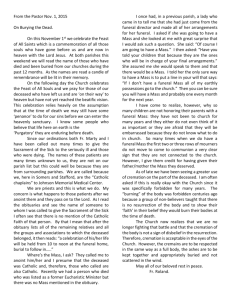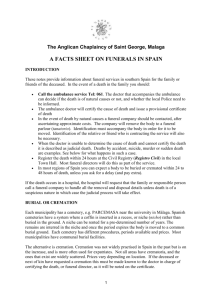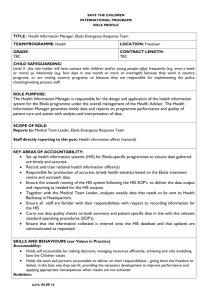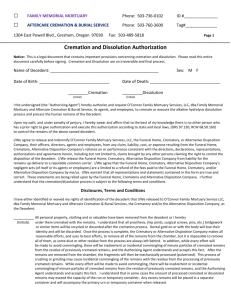Ebola-protocol-nfda-template-FINAL.ORIG_
advertisement
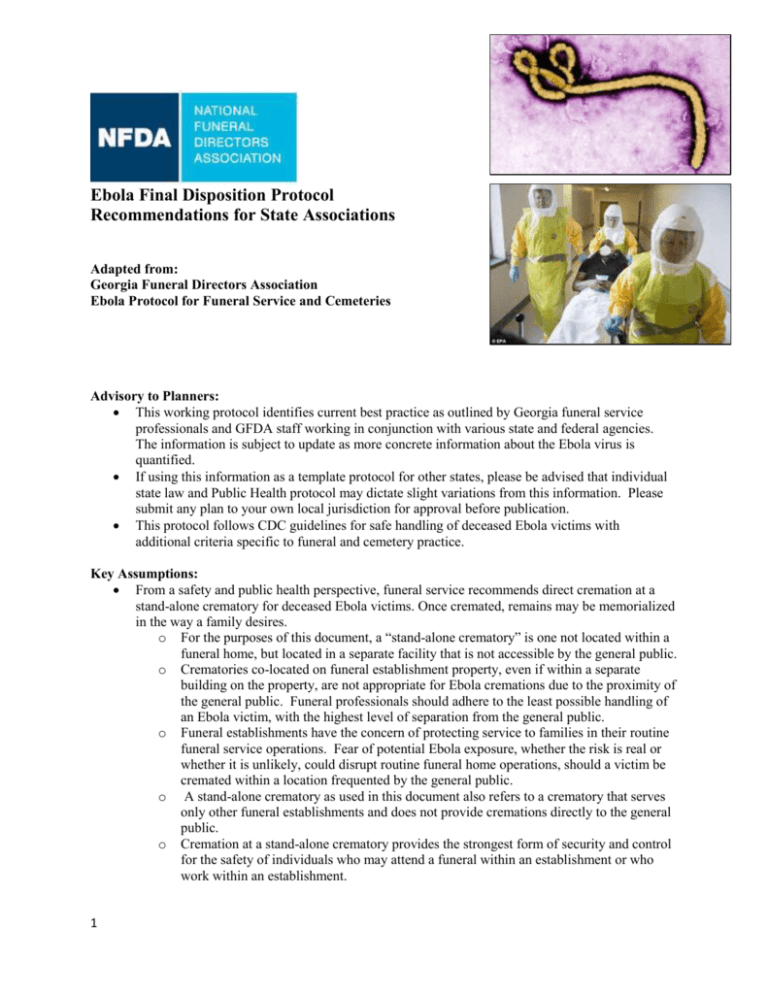
Ebola Final Disposition Protocol Recommendations for State Associations Adapted from: Georgia Funeral Directors Association Ebola Protocol for Funeral Service and Cemeteries Advisory to Planners: This working protocol identifies current best practice as outlined by Georgia funeral service professionals and GFDA staff working in conjunction with various state and federal agencies. The information is subject to update as more concrete information about the Ebola virus is quantified. If using this information as a template protocol for other states, please be advised that individual state law and Public Health protocol may dictate slight variations from this information. Please submit any plan to your own local jurisdiction for approval before publication. This protocol follows CDC guidelines for safe handling of deceased Ebola victims with additional criteria specific to funeral and cemetery practice. Key Assumptions: From a safety and public health perspective, funeral service recommends direct cremation at a stand-alone crematory for deceased Ebola victims. Once cremated, remains may be memorialized in the way a family desires. o For the purposes of this document, a “stand-alone crematory” is one not located within a funeral home, but located in a separate facility that is not accessible by the general public. o Crematories co-located on funeral establishment property, even if within a separate building on the property, are not appropriate for Ebola cremations due to the proximity of the general public. Funeral professionals should adhere to the least possible handling of an Ebola victim, with the highest level of separation from the general public. o Funeral establishments have the concern of protecting service to families in their routine funeral service operations. Fear of potential Ebola exposure, whether the risk is real or whether it is unlikely, could disrupt routine funeral home operations, should a victim be cremated within a location frequented by the general public. o A stand-alone crematory as used in this document also refers to a crematory that serves only other funeral establishments and does not provide cremations directly to the general public. o Cremation at a stand-alone crematory provides the strongest form of security and control for the safety of individuals who may attend a funeral within an establishment or who work within an establishment. 1 o o 2 At the present time, the post-mortem viability of the Ebola virus is unknown. Recent studies have suggested that even at ten weeks post-mortem, the virus is still active. Death care professionals believe it is unsafe, impractical and risky to bury deceased Ebola victims due to the inability to adequately ensure the security of the remains and the grave site during the time the virus remains active post-mortem. Further risks accrue due to the potential hazards of transporting, vaulting, and burying said remains. There is no guarantee that the burial containers will remain whole and unbreached whether at time of disposition or through disruption by third parties after interment. In the United States, religious considerations are protected rights under the Constitution; however, those rights are balanced by authorities granted to federal and state Public Health agencies with statutory responsibility to protect their populations. In most states, the chief health officer, in conjunction with the Governor, has the authority to declare the form of final disposition for any deceased that presents a public health risk. This document recognizes that individual states will need to clarify that decision within their protocol. For Ebola hospital deaths, most individuals can be expected to live for at least a period of time after diagnosis and admission. For this reason, funeral professionals recommend a 2-hour postmortem period for families to object to cremation on religious grounds. The period after admission should be used to communicate with family regarding preferred form of final disposition should death result. o The diagnosis of Ebola is generally understood by most individuals to high-risk and highly infectious. A shortened religious objection timeframe combined with family preplanning discussion prior to a death, ensures that final disposition plans can be enacted fairly quickly, eliminating the possibility that the deceased awaits disposition for an indefinite time at the location where he or she expired. o The ante-mortem disposition discussion is particularly important because families could be far-flung and not necessarily at the geographic location of an Ebola death. o Protocols should be in place within the hospital so that final disposition options are fully discussed with families after diagnosis, leaving plenty of time for staff to discuss cremation as a way to halt infection and protect the public. Funeral directors can assist their local hospital in developing this protocol. o Funeral directors can aid families by reminding them that cremated remains can be buried, in order to offer a final resting place for their loved one. This plan outlines the steps for both cremation and burial, recognizing that cremation is the recommended final disposition from the funeral profession. THE DECEASED SHOULD BE REMOVED FROM THE PLACE OF DEATH ONLY WHEN THE FINAL DISPOSITION FORM IS KNOWN (CREMATION OR BURIAL) AND WHEN THE CREMATORY OR GRAVESITE IS FULLY PREPARED TO ACCEPT THE BODY. If cremation cannot be accomplished for whatever reason, it is highly recommended that the gravesite NOT be made public. The location should be redacted from the death certificate under the authority of Public Health, at least until the post-mortem lifespan of the Ebola virus is known. Ebola has been listed as a potential weapon of mass destruction; gravesites will need to be secured for the period of time that the virus is live. States will have to consider this concern when achieving final disposition, including who will bear the responsibility for securing the gravesite. Equipment PPE: Full Level A pathogen protection (full body/ head/neck coverage and respirator for attendants in room where deceased died. Also recommended for ante-room area. o Note: in response to Ebola, many hospitals have secured this level of PPE. Discuss with your local hospital as to whether you should secure PPE or if the hospital will have it onhand. Church truck with no drapes Rigid outer container (for cremation) OR minimum 20-guage metal casket (for burial) Bioseal—CDC calls for a “hermetic” seal covering the body. BioSeal is the only substance with a true hermetic seal. Metal caskets are not considered a hermetic seal. Portable container/sprayer with decontamination liquid per CDC recommendations or at least 1/10 bleach to water solution. Gloves Body bags with handles. Any zippers may be sealed with surgical tape or duct tape. These can typically be supplied by the hospital. Shoe covers Biohazard waste disposal bags (supplied and then destroyed by hospital) Unmarked van for transportation Who Responds In Your State The assumption is that certain hospitals in each state have been designated as Ebola-ready. These facilities will have dedicated isolation rooms with antechamber/negative air pressure where decontamination and bagged body transfer takes place. We recommend a trained, separate death care response team comprised of individuals who are familiar and comfortable with hazmat response at all levels. We do not recommend that individual funeral homes and employees attempt Ebola response on their own. The Death Care Response Team response is comprised of two different functions or steps: enclosure and transportation. In many hospitals, the Enclosure Team functions will be performed by medical personnel who have already been in the room where the deceased expired. In other instances, enclosure may be performed by the death care team. Enclosure team. Accepts the deceased from the medical team, place him/her on church truck with deceased already in body bags, decontaminate, place in metal casket or rigid alternate container, decontaminate, move to the safe area outside the isolation room to waiting transport team. Transportation team. Outside the isolation area, accepts the decontaminated deceased already on the church truck and in hermetically sealed container (BioSeal) from the Enclosure team members. Transports to transport vehicle and directly to crematory or grave site. Multi-person team depending on weight of deceased. Important because moving deceased weight in a non-rigid container increases risk of exposure (ripping, tearing body bags, etc.) Adequate manpower is required. 2-person team “mid-infection-zone” if =/< 150 lbs. 4-person for 150 pounds+ Response team must include at least one funeral director. The overall team could be all funeral service or could also include individuals already trained in hazmat such as EMS, fire, etc. 3 A funeral director of the family’s choice should also be contacted after the death. This individual is responsible for communicating with the family and serving as go-between with hospital, others. Remember that the family will not be in direct contact with the deceased post-mortem. The family could potentially be in quarantine themselves. This will be an evolving situation; the funeral director will provide a much-needed support system for the family. Each state evaluates its own law and requirements for documents and who is responsible. Vary by state and could include: Death certificate Burial transport permit Family authorization. Public health authorization using statutory powers (if granted in that state) Hospitals/others attending deceased should have internal protocols already in place as to who notifies the family (could vary based on if family is quarantined or not). In an optimal situation, a public announcement of death should be withheld from news media until final disposition is completed. This allows all participants to operate confidentially and without interruption, with the highest level of respect for deceased. Initiating the Mortuary Process SLOW DOWN. Once death has occurred, the room will be as contaminated at the highest contamination level it will attain. Hospital / coroner calls the mortuary response team telephone contact number to initiate response ONLY WHEN THE FINAL DISPOSITION FORM IS KNOWN (CREMATION OR BURIAL). On-site personnel with the deceased should determine, with input from public health and family: Final disposition of either cremation or burial. (This affects what the team will bring with them—rigid alternate container, 20-guage metal casket) and where they will be transporting the deceased. Weight of individual should be given to team; this affects the number of people who will respond. One telephone number state-wide given to all hospitals, coroners, crime labs, etc.. Use a 24/7, 365 answering service with dedicated response team number. (already in place and used by funeral homes). Response team members have an on-call schedule to respond to hospitals, unattended, any place needed for Ebola death. Hospital or other location where deceased resides leaves the body in place. Do not move to any other location; room is as contaminated as it is going to get. Hospital should already have identified in its plan: The most secure route from the isolation room to a secure area where body can be transported to a van. The most secure transport pick-up location on hospital grounds that will provide for least exposure to the public and to the media. Crematory should be open and ready to cremate immediately upon arrival of deceased. If burial is selected, grave space should be completely ready to accept deceased including a vault with a lid. (Minimum standard Wilbert Monticello or comparable; no air seal vaults should be used.) 4 Removal 5 The deceased is in the room where he or she expired. (Called the HOT Zone). Full Level A pathogen PPE. Wheeled cot should be in the room next to bed. Metal, able to be decontaminated. First body bag should be placed, open, on the cot. Medical team leaves all tubes, clothing, gowns in place, wraps the deceased in the bedsheet, uses bedsheet to lift body into body bag already open on rolling metal cot. NOTE: If your state has a participating hospital without an isolation unit, this plan will be modified slightly. In that case, one person from the Mortuary team will join the medical personnel in the room to assist with placement of body into body bags. All states should discuss with their local hospital. Leave bedsheet with body, close body bag. Decontaminate this first bag with solution 1:10 bleach and water. Specifically, decontaminate top and cot, turn bag over and decontaminate back side. Roll back over. BioSeal the first body bag. Decontaminate as before. Note: BioSeal is considered “hermetically sealed” as it is aluminum to aluminum seal. Place Biosealed body into final body bag. This final bag should have handles. Decontaminate as before, both sides and cot. Medical personnel certify identity of deceased. A pad saturated with decontamination solution should be on the floor leading from the Hot Zone into the anteroom to disinfect the wheels of the cot. Roll cot into anteroom of isolation room. Medical personnel step back into hot zone and await the departure of the Enclosure Team. Medical personnel doff PPE in the anteroom after 6 Enclosure team and Transportation team leave per CDC protocol, using the buddy system for PPE removal (doffing) to ensure complete decontamination. Enclosure team comes into the anteroom, full Level A pathogen PPE, with church truck and rigid alternate container (for cremation) or 20-guage metal casket (for burial). Note: the church truck has never been in the hot zone, while the cot has been decontaminated 3X at this point. They move the body into the container and close it. They decontaminate the container and the church truck and allow them to air dry. A pad saturated with 1:10 bleach solution or other solution as recommended by CDC should be on the floor to the exit of the anteroom. The Transport Team (2 people) is waiting in a clean area outside the isolation anteroom. Transport team is in PPE (Normal surgical mark, double gloved with cuffs tucked into gloves, eye covering, Hospital secures its pre-selected route from isolation room to transport vehicle. Transport team follows this route to van. Enclosure team decontaminates themselves and doffs PPE, using the buddy system, then leave the anteroom. Medical personnel enter anteroom, again decontaminate the cot. Medical personnel then decontaminate themselves in the anteroom and doff PPE, using buddy system. All used PPE should go into biohazard bags within the hospital that will use its biohazard waste management system to dispose of properly. 7 Transportation—2 people waiting outside anteroom Place metal body tag by affixing to OUTERMOST container. The 2-person Transportation Team rolls the body on the church truck to the van. The van should NOT be a hearse. It should be n unmarked van or other vehicle with only metal in the area where the body will sit, able to be decontaminated. Team, still in PPE, rolls the body off the church truck into the vehicle. They decontaminate the church truck. Allow it to air dry. o The Enclosure team will pick it up on their way out. Transport team decontaminates, doffs PPE using buddy system, and places used PPE in biohazard bag. They get in the vehicle and drive to crematory or burial site. Human remains are exempt from DOT hazmat regulations; however, due to the highly infectious nature of Ebola, it is recommended to have an escort vehicle. No lights or siren. This ensures another set of eyes on the process ion who can secure the scene in the event of an accident (tire blows out, rear-end collision, etc.). The second part of the team, the Enclosure team, will be in similar vehicle. If something disables the first vehicle, the second will take over. The team takes the body directly to a crematory. Recommended: stand-alone crematory in industrial/commercial area. This is to protect the funeral establishment from public fear, allowing the regular deaths within a community to be served. Cremation THE DECEASED SHOULD BE REMOVED FROM THE PLACE OF DEATH ONLY WHEN THE FINAL DISPOSITION FORM IS KNOWN (CREMATION OR BURIAL) AND WHEN THE CREMATORY OR GRAVESITE IS FULLY PREPARED TO ACCEPT THE BODY. Funeral directors can help families by reminding them that cremated remains can be buried and memorialized at a final resting place. Recommendations for the preferred method of final disposition for Ebola victims would be cremation. It is also believed that most families will be interested in preventing any further infection. 8 The Transportation team arrives at the crematory. All areas are secure—no public or media. The transport team should ensure that additional PPE, biohazard bags, bleach or other approved decontamination solution and other required equipment travel to the gravesite with them. The biohazard bags and bleach/decon solution should be placed outside the van for use after body is placed in retort. The team dons PPE which they have with them in the van. The retort should already be open. Unload the body. Take it directly to the retort. The transportation team unloads the body into the retort and they close the retort. The certified crematory operator does not approach the body. He or she remains away from the retort until the body is inside. He or she then operates the crematory in basic PPE. The transportation team never touches the crematory controls. The transportation team returns to the vehicle. They decontaminate the inside of the vehicle with 1:10 bleach solution. The allow it to air dry. They decontaminate the church truck and allow it to air dry. They doff their PPE and place it in biohazard bags. The crematory operator should do the following: o Do not open the retort or reposition the body for Ebola victims. o Allow the cremation to continue for 6-8 hours without interruption to ensure full cremation has taken place. o Wear standard PPE until the end of the process. No infectious agent should remain by the end of cremation; however, in an abundance of caution, use PPE both for this reason and for standard reasons of not inhaling dust from the cremated particles. Pulverize the remains as in a typical cremation. Place cremated remains in a sealed urn—again in an abundance of caution. o Decontaminate the outside of the urn. o At this point, cremated remains pose no health threat. Burial THE DECEASED SHOULD BE REMOVED FROM THE PLACE OF DEATH ONLY WHEN THE FINAL DISPOSITION FORM IS KNOWN (CREMATION OR BURIAL) AND WHEN THE CREMATORY OR GRAVESITE IS FULLY PREPARED TO ACCEPT THE BODY. If cremation cannot be accomplished for whatever reason, it is highly recommended that the gravesite NOT be made public. The location should be redacted from the death certificate under the authority of Public Health, at least until the post-mortem lifespan of the Ebola virus is known. Ebola has been listed as a potential weapon of mass destruction; gravesites will need to be secured for the period of time that the virus is live. States will have to consider this concern when achieving final disposition, including who will bear the responsibility for securing the gravesite. Remember that Ebola victims will not be embalmed and will have additional time considerations for interment. Refrigeration has not been studied and is NOT recommended because it would involve potential contamination of refrigeration units. Recommendations for the preferred method of final disposition for Ebola victims would be cremation. It is also believed that most families will be interested in preventing any further infection. However, there will be bone fide cases of religious preference where that is not practical. There could be rare instances of obesity where an individual cannot be safely cremated (fatty tissue, repositioning concerns, etc.) NOTE: a funeral director must be present during interment. This can be one of the team members or the funeral director selected by the family. In the event that burial is the final disposition method, the gravesite should be completely ready to accept the body prior to the body leaving the hospital. This includes the open grave, lowering mechanism and vault with lid (Wilbert Monticello or comparable, no air seal). The Response team should not even go to the hospital for removal until this step is completed. The Transport team takes the body directly to the gravesite. The transport team should ensure that biohazard bags, bleach solution and other required equipment travel to the gravesite with them. These items should be placed outside the van for use after the body is placed in the grave. The van should be driven as close to the grave as possible. Extreme caution should be used when transporting the body to the grave. This step is potentially high-risk. Some cemeteries have special vehicles for transportation over uneven terrain. No cemetery workers or non-essential personnel should be close to the grave during unloading. Transport team places the body in the vault. The vault is closed. Transport team returns to the van and decontaminates the van and any transport cot; these airdry. 9 Vault is lowered and covered over with dirt. At that point, the site is safe to approach from ground level. However, cemeteries will have the task of ensuring on-going/round-the-clock gravesite security for the lifespan of post-mortem Ebola virus. The Transport team doffs PPE and places it in the biohazard bag. Special Weather Conditions For some areas of the country, burial in winter months is already postponed due to harsh and frozen ground conditions. Remember that Ebola victims will not be embalmed. Refrigeration techniques are largely unstudied in relation to Ebola and risks contamination of refrigeration units. Cremation should be strongly considered in this event. If not possible, those states will need to work closely with Public Health and CDC for a suitable solution. Memorialization The family will have selected a funeral director while the body is still in the hospital. That funeral director should be prepared to be at the crematory or gravesite as a witness to the final disposition if requested by the family. Funeral directors should expect fairly intense communication; after the death, he or she becomes the primary contact for virtually everything (unless the family is quarantined which involves ongoing contact with Public Health.) This funeral director will be in touch with the family to comfort them, explain what is occurring, outline their options for memorialization. Depending on what a state elects as protocol, this director may or may not be the person who talks with the family about cremation versus burial. Key messages: o Directors should be prepared to support the highest level of public safety and discuss the recommendations for cremation for an Ebola victim. o The importance of memorialization—could be a memorial service with the cremated remains, a graveside committal service after everything is completed, could be several weeks in the future if the family was quarantined. o Communication may be in person, by telephone, email. o Public information about the death should be postponed until final disposition is achieved. Funeral directors can help educate the family about the importance of this protective step. Particular attention should be given to news media (which are fairly obvious to most families); however, it is equally important to educate them about social media of all types (Facebook, Twitter, cell phone texts and the like). Identification of Body Does the hospital know who the body is? o If so, in lieu of family ID, take affidavit from the hospital. We can create such an affidavit. If identify unknown, Public health can declare a “John Doe” and photograph the victim for future possible identification. Camera can be a cell phone enclosed in a plastic bag to prevent contamination. The standard body tag will be on the outermost container with an anti-tamper lock. Unattended deaths Public Health and the medical examiner/coroner will be in charge with a home-based Ebola death. The mortuary team should not be involved until the scene is secure, the deceased is enclosed in body bags, and the scene is decontaminated. A home death would indicate an uncontrolled infectious environment with extreme caution for responders. 10 Otherwise, all removal and transportations protocols remain the same. Doesn’t matter if the deceased is in a home, a crime lab, a nursing home, etc. The mortuary team should not be mobilized for removal and transportation until the form of final disposition is known. Required Forms Death certificate: each state will decide who can sign. Public health and/or the hospital will sign on pronouncement and cause of death in most cases. Funeral director selected by the family will sign in funeral director capacity. If none selected, the funeral director on the Response team can sign and attest. States should consider redacting the funeral home name off the death certificate. A separate transport team operating under Public Health will include a funeral director who can sign the death certificate. The death certificate should state “mortuary team” and “stand-alone crematory”. Otherwise, there is a risk of interrupting the routine burials performed by the funeral home. Burial transport: due to the extreme nature of an Ebola death, it is anticipated that the hospital will have on-hand the signed appropriate forms from that county or state to effect transport if required in your state for transport or for cremation. Family forms: It is recommended that as part of this protocol, each hospital have a form that the family would sign upon admission of an Ebola patient. Within that form, (similar to many states health care Power of Attorney) there is a section for preferred method of final disposition and WHO is next of kin to make that decision. It may be very difficult to find or determine next of kin in some Ebola situations; families could literally be anywhere geographically. Final disposition should not be unduly delayed by looking for next of kin, sorting through an argument about next of kin, or similar problems funeral directors routinely experience. Public Health in each state could create such a form. NOTE: It is suggested that the state Public Health not allow out-of-state transmission of transportation of an Ebola body. Victims will not be embalmed, so transporting an Ebola deceased is extremely risky. If cremation cannot be accomplished and if burial is selected, it is recommended that it be in state, using the family funeral director of choice and the Ebola mortuary response team, with immediate burial. Who Pays The statutory authorities in each state will have to answer this issue as to the response team and public safety portion of the final disposition. Memorialization should remain at the cost of the family. 11
